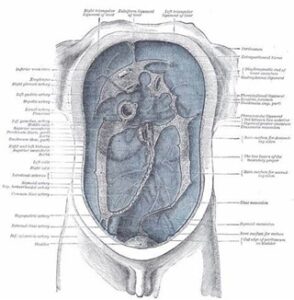Peritoneum Anatomy
 The peritoneal cavity is a potential space between the parietal and visceral peritoneum.
The peritoneal cavity is a potential space between the parietal and visceral peritoneum.
It normally contains only a thin film of peritoneal fluid, which consists of water, electrolytes, leukocytes and antibodies. This fluid acts as a lubricant, enabling free movement of the abdominal viscera, and the antibodies in the fluid fight infection.
While the peritoneal cavity is ordinarily filled with only a thin film of fluid, it is referred to as a potential space because excess fluid can accumulate in it, resulting in the clinical condition of ascites.
he peritoneal cavity can be divided into the greater and lesser peritoneal sacs. The greater sac comprises the majority of the peritoneal cavity. The lesser sac (also known as the omental bursa) is smaller and lies posterior to the stomach and lesser omentum.
Greater Sac
The greater sac is the larger portion of the peritoneal cavity. It is further divided into two compartments by the mesentery of the transverse colon (known as the transverse mesocolon):
Supracolic compartment – lies above the transverse mesocolon and contains the stomach, liver, and spleen.
Infracolic compartment – lies below the transverse mesocolon and contains the sall intestine, ascending and descending colon. The infracolic compartment is further divided into left and right infracolic spaces by the mesentery of the small intestine.
The supracolic and infracolic compartments are connected by the paracolic gutters which lie between the posterolateral abdominal wall and the lateral aspect of the ascending or descending colon.
Lesser Sac (Omental Bursa)
The lesser sac lies posterior to the stomach and lesser omentum. It allows the stomach to move freely against the structures posterior and inferior to it.
The omental bursa is connected with the greater sac through an opening in the omental bursa – the epiplois foramen (of Windslow).
The epiploic foramen is situated posterior to the free edge of the lesser omentum (the hepatoduodenal ligament).
Structure of the Peritoneal Cavity in the Pelvis
Due to the presence of different pelvic organs, the peritoneal cavity differs in structure between the sexes. The primary difference in structure is the location of the most distal portion of the cavity.
When humans stand or sit upright, any superfluous fluid (which could be blood, pus, or infected fluid) is likely to collect in the most inferior portion of the peritoneal cavity. Thus, it is clinically important to be aware of the differences between males and females.
Male
In males, the rectovesical pouch is a double folding of peritoneum located between the rectum and the bladder. The peritoneal cavity is completely closed in males.
Females
In females, there are two areas of note:
Rectouterine pouch (of Douglas) – double folding of the peritoneum between the rectum and the posterior wall of the uterus.
Vesicouterine pouch – double folding of peritoneum between the anterior surface of the uterus and the bladder.
The peritoneal cavity is not completely closed in females – the uterine tubes open into the peritoneal cavity, providing a potential pathway between the female genital tract and the abdominal cavity. Clinically, this means that infections of the vagina, uterus, or uterine tubes may result in infection and inflammation of the peritoneum (peritonitis).
Actual passage of infectious material into the peritoneum, however, is rare due to the presence of a mucus plug in the external os (opening) of the uterus which prevents the passage of pathogens but allows sperm to enter the uterus.




